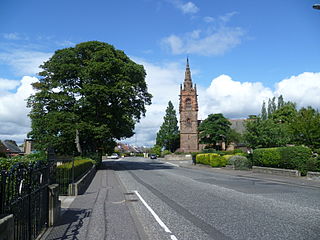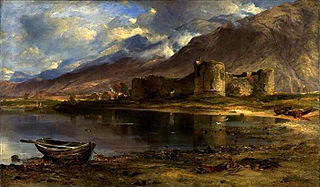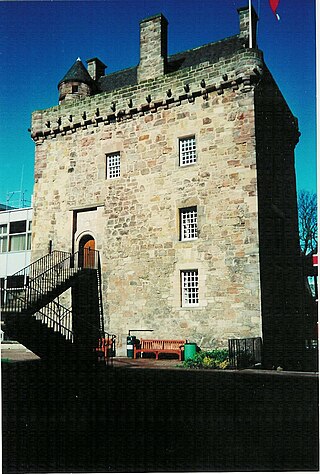
Edinburgh Napier University is a public university in Edinburgh, Scotland. Napier Technical College, the predecessor of the university, was founded in 1964, taking its name from 16th-century Scottish mathematician and philosopher John Napier. The technical college was inaugurated as a university in 1992 by Lord Douglas-Hamilton, becoming Napier University. In 2009, the university was renamed Edinburgh Napier University.

Duart Castle, or Caisteal Dhubhairt in Scottish Gaelic, is a castle on the Isle of Mull, beside the Sound of Mull off the west coast of Scotland, within the council area of Argyll and Bute. The castle dates back to the 13th century and is the seat of Clan MacLean. One source states that the castle was "brought back from ruin in 1911".

Craiglockhart is a suburb in the south west of Edinburgh, Scotland, lying between Colinton to the south, Morningside to the east Merchiston to the north east, and Longstone and Kingsknowe to the west. The Water of Leith is also to the west.

Merchiston Castle School is an independent boarding school for boys in the suburb of Colinton in Edinburgh, Scotland. It has around 470 pupils and is open to boys between the ages of 7 and 18 as either boarding or day pupils; it was modelled after English public schools. It is divided into Merchiston Juniors, Middle Years and a Sixth Form.
Merchiston is a residential area around Merchiston Avenue in the south-west of Edinburgh, Scotland.

Holy Corner is a colloquial name for a small area of Edinburgh, Scotland, and is part of the area more properly known as Burghmuirhead, itself part of the lands of Greenhill. Holy Corner lies between the areas of Bruntsfield and Morningside.

Clan Napier is a Lowland Scottish clan.

Lauriston Castle is a 16th-century tower house with 19th-century extensions overlooking the Firth of Forth, in Edinburgh, Scotland. It lies on Cramond Road South, between Cramond, Davidson's Mains, and Silverknowes. The substantial grounds, Lauriston Castle Gardens, operate as a local park. The castle was bequeathed to the Edinburgh Corporation and hosts the Lord Provost's annual Garden Party. The house is a Category A listed building and the grounds are included in the Inventory of Gardens and Designed Landscapes in Scotland.

Culcreuch Castle is a Scottish castle close to the village of Fintry, near Loch Lomond. It had been the home of the Barons of Culcreuch since 1699. In the 1980s the castle was converted into a hotel, which it was run as until early 2020 when it was closed to the public by the American owners thus ending over 700 years of history. It had been until January 2020 one of the most continually inhabited Castles in Central Scotland.

Clan Guthrie is a Scottish clan.

Inverlochy Castle is a ruined, 13th-century castle near Inverlochy and Fort William, Highland, Scotland. The site of two battles, the castle remains largely unchanged since its construction. It is now in the care of Historic Environment Scotland.

Archibald Napier, 1st Lord Napier, the 9th Laird Napier of Merchiston, was a Scottish politician and judge. In 1627 he was created Lord Napier of Merchiston and Baronet of Nova Scotia.
The Ian Tomlin School of Music, established 1968, is situated within the grounds of Merchiston campus at Edinburgh Napier University, Edinburgh, Scotland. The school is home to the BMus (Classical) and BA (Popular) Music courses. The courses are taught over three or four years. The school also offers research PhDs within its Applied Music Research Centre, primarily around composition and technology.

Prestongrange House is a historic house at Prestongrange near Prestonpans, East Lothian, Scotland, UK. It is situated near to two other historic houses, Hamilton House and Northfield House.
Merchiston is an area of Edinburgh in Scotland.
Sir Archibald Napier was a Scottish landowner and official, master of the Scottish mint and seventh Laird of Merchiston.
Events in the year 1608 in Scotland.
Sir Alexander Seton of Gargunnock and Culcreuch, Lord Kilcreuch was a 16th- and 17th-century Scottish judge and Senator of the College of Justice.

Sir Alexander Napier, Lord Laurieston was a 17th-century Scottish landowner, judge and Senator of the College of Justice. He was half-brother of the mathematician John Napier.
Stuart Lowe Harris was a Scottish architect and historian. He worked for 34 years in the Architects Department of Edinburgh Council, where he rose to the post of Depute City Architect. He was responsible for several notable public building projects, including the Meadowbank Sports Centre and the failed plan to build an opera house in the city. He was deeply interested in local Edinburgh history, and published several books and many articles on the subject, including a definitive work on the origins of local place names.















